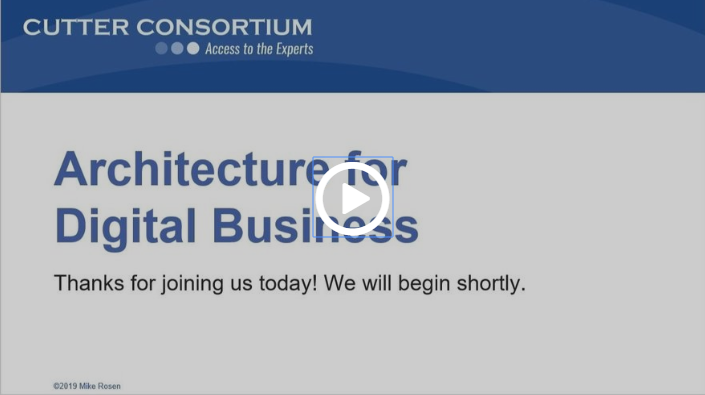What does architecture for digital transformation look like?
Is your organization undergoing a digital transformation initiative? Then you know how important architecture and technology is to building a sustainable foundation. Yet so much has changed in the past two or three years that it’s hard to know what that should look like. The environment is now part of a larger business ecosystem. Scale, speed, and scope are greatly expanded. Business architecture is different. Information and data architecture are different. Application architecture is different. Technology architecture is different. Security architecture is different. And, how they all fit together is different, too.
 During this two-day training session, Cutter Senior Consultant Mike Rosen will share the requirements for the new digital economy and describe the new “Digital Business Platform” necessary to meet those requirements and sustain success. You and your team will understand the overall architecture needed to create that platform and dive deep into the new business, information, application, technology, performance, and security architectures that comprise it. A detailed case study is woven throughout the course to illustrate the platform, architectural tradeoffs, and a wide variety of work products across all domains. Interactive exercises give you an opportunity to use the new techniques in real time.
During this two-day training session, Cutter Senior Consultant Mike Rosen will share the requirements for the new digital economy and describe the new “Digital Business Platform” necessary to meet those requirements and sustain success. You and your team will understand the overall architecture needed to create that platform and dive deep into the new business, information, application, technology, performance, and security architectures that comprise it. A detailed case study is woven throughout the course to illustrate the platform, architectural tradeoffs, and a wide variety of work products across all domains. Interactive exercises give you an opportunity to use the new techniques in real time.
Discover why your organization should use a business architecture and value delivery–based approach to digital strategy. Watch the complete webinar now.
"Accommodating the speed of business change is the most important architectural quality we can build into our systems today. What does that mean? It means we make different tradeoffs than we made before. It means we trade off other things, such as complexity, for the ability to change quickly."
—Mike Rosen, Senior Consultant, Cutter Consortium
What your team will learn:
- Why the digital economy requires a new platform and architecture
- The overall architecture for the “Digital Business Platform”
- How to use business architecture to evaluate and plan digital transformation opportunities and shape the platform requirements
- The new information and data architecture to support cognitive intelligence and the ‘sense, compute, act’ paradigm and typical usage patterns that drive tradeoffs
- Performance architecture for providing real time reporting on key enterprise business outcomes
- Application architecture in the era of microservices, containers, APIs, DaaS, FaaS, PaaS
- Cloud and hybrid technology architectures for a sustainable, scalable, reliable flexible business platform
- Security architecture to ensure Digital Trust, including Intelligence, AI, and SECaaS
Course Requirements: This course is delivered at your organization. Attendees should have an understanding of enterprise architecture and a familiarity with a variety of architectural models and deliverables.
Course Outline:
- What is Digital Transformation?
- Digital Transformation Defined
- Four Dimensions of Transformation
- Business Model, Operating Model, Information, Technology
- Sense, Compute, Act
- The New Application Paradigm
- Application Examples
- Business and Operating Models and Strategies
- Digital Business Models
- Digital Operating Models
- Evaluating Opportunities
- Architecting the new Digital Business Platform
- Intelligence, Experience, Application, Infrastructure
- The new architecture framework
- Transforming architecture
- Business Architecture
- BA overview
- Articulating strategies
- Capability framework
- Case Study
- Planning strategy to execution
- Value based planning
- Performance Architecture
- Outcomes, Critical Success Factors, KPIs
- Business Motivation Model
- Performance framework
- Information Architecture
- Decision Centric Computing
- Cognitive approaches
- AI, ML, DL
- Data lakes
- Data patterns
- Application Architecture
- Microservices, services, and APIs
- CaaS, FaaS
- PaaS
- DevOps
- Rationalization and Technical Debt
- Technology Architecture
- Hybrid solutions
- Cloud transition strategies
- Integration
- Security Architecture
- State of cybersecurity
- Four disciplines of security management
- Digital trust
- GDPR
- Blockchain
- Conclusion
What's Next?
For more details on how Cutter can help your organization create an architecture for a digital business platform, complete the form below, send an email to your Cutter Account Executive, or call +1 781 648 8700.



